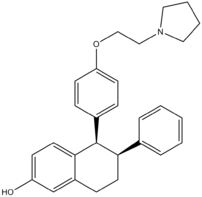Lasofoxifene
 | |
| Clinical data | |
|---|---|
| ATC code | G03XC03 (WHO) |
| Identifiers | |
| |
| CAS Number |
180916-16-9 |
| PubChem (CID) | 216416 |
| IUPHAR/BPS | 7542 |
| ChemSpider |
187585 |
| UNII |
337G83N988 |
| ChEMBL |
CHEMBL328190 |
| Chemical and physical data | |
| Formula | C28H31NO2 |
| Molar mass |
413.55 g/mol 563.64 g/mol (tartrate) |
| 3D model (Jmol) | Interactive image |
| |
| |
| | |
Lasofoxifene (INN) (brand name Fablyn) is a non-steroidal selective estrogen receptor modulator (SERM) which is marketed by Pfizer for the prevention and treatment of osteoporosis and for the treatment of vaginal atrophy,[1] and the result of an exclusive research collaboration with Ligand Pharmaceuticals (LGND). It also appears to have had a statistically significant effect of reducing breast cancer in women according to a study published in The Journal of the National Cancer Institute.
Indications
Osteoporosis
In postmenopausal women with osteoporosis, lasofoxifene at a dose of 0.5 mg per day was associated with reduced risks of nonvertebral and vertebral fractures, ER-positive breast cancer, coronary heart disease, and stroke but an increased risk of venous thromboembolic events.[2][3]
Breast cancer prevention
In studies of breast cancer prevention, lasofoxifene showed a 79% reduction in breast cancer incidence and an 83% reduction specific incidence of estrogen receptor-positive breast cancers, which is significantly higher than reductions found with the related SERMs tamoxifen and raloxifene.[4] In accordance, a meta-analysis of SERMs for breast cancer prevention found the highest reduction in risk with lasofoxifene of all the drugs.[5] The reduction was even greater than that observed with aromatase inhibitors, which have generally been found to confer a greater risk reduction than SERMs.[5]
Pharmacology
Lasofoxifene selectively binds to both ERα and ERβ with high affinity.[6] Its IC50 for ERα (1.5 nM) is similar to that of estradiol (4.8 nM) and is at least 10-fold higher than those of tamoxifen and raloxifene.[2] Raloxifene also has remarkably improved oral bioavailability relative to tamoxifen and raloxifene, and this may also be involved in its greater potency.[7]
Chemistry
Lasofoxifene is a naphthalene derivative[6] and a desmethyl dihydro analogue of nafoxidine.[8]
History
In September 2005, Pfizer received a non-approvable letter from the U.S. Food and Drug Administration regarding lasofoxifene (trade name Oporia), a selective estrogen receptor modulator for the prevention of osteoporosis.
On January 2008, Ligand Pharmaceuticals, through its marketing partner, Pfizer, submitted a New Drug Application for lasofoxifene, which is expected to be marketed under the tradename Fablyn. Lasofoxifene was approved in the EU under the brand name Fablyn by the EMEA in March 2009.[9]
References
- ↑ Gennari L, Merlotti D, Martini G, Nuti R (September 2006). "Lasofoxifene: a third-generation selective estrogen receptor modulator for the prevention and treatment of osteoporosis". Expert Opinion on Investigational Drugs. 15 (9): 1091–103. doi:10.1517/13543784.15.9.1091. PMID 16916275.
- 1 2 Gennari L, Merlotti D, Nuti R (2010). "Selective estrogen receptor modulator (SERM) for the treatment of osteoporosis in postmenopausal women: focus on lasofoxifene". Clinical Interventions in Aging. 5: 19–29. doi:10.2147/cia.s6083. PMC 2817938
 . PMID 20169039.
. PMID 20169039. - ↑ Cummings SR, Ensrud K, Delmas PD, LaCroix AZ, Vukicevic S, Reid DM, Goldstein S, Sriram U, Lee A, Thompson J, Armstrong RA, Thompson DD, Powles T, Zanchetta J, Kendler D, Neven P, Eastell R (February 2010). "Lasofoxifene in postmenopausal women with osteoporosis". The New England Journal of Medicine. 362 (8): 686–96. doi:10.1056/NEJMoa0808692. PMID 20181970.
- ↑ I. Craig Henderson (27 October 2015). Breast Cancer. Oxford University Press, Incorporated. pp. 31–. ISBN 978-0-19-991998-7.
- 1 2 Mocellin S, Pilati P, Briarava M, Nitti D (February 2016). "Breast Cancer Chemoprevention: A Network Meta-Analysis of Randomized Controlled Trials". Journal of the National Cancer Institute. 108 (2). doi:10.1093/jnci/djv318. PMID 26582062.
- 1 2 Gennari L (June 2006). "Lasofoxifene: a new type of selective estrogen receptor modulator for the treatment of osteoporosis". Drugs of Today. 42 (6): 355–67. doi:10.1358/dot.2006.42.6.973583. PMID 16845439.
- ↑ Gennari L (September 2009). "Lasofoxifene, a new selective estrogen receptor modulator for the treatment of osteoporosis and vaginal atrophy". Expert Opinion on Pharmacotherapy. 10 (13): 2209–20. doi:10.1517/14656560903127241. PMID 19640205.
- ↑ Lednicer D, Emmert DE, Lyster SC, Duncan GW (September 1969). "Mammalian antifertility agents. VI. A novel sequence for the preparation of 1,2-disubstituted 3,4-dihydronaphthalenes". Journal of Medicinal Chemistry. 12 (5): 881–5. doi:10.1021/jm00305a038. PMID 5812203.
- ↑ "Fablyn - lasofoxifene". European Medicines Agency. 7 August 2009. Archived from the original on 13 April 2010.
External links
- "Reference site for lasofoxifene information". Anakena Internet Services SL. Retrieved 2008-03-18.